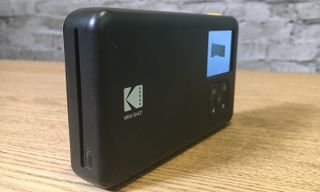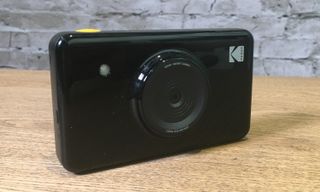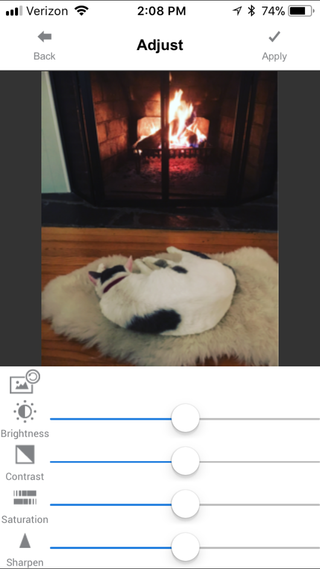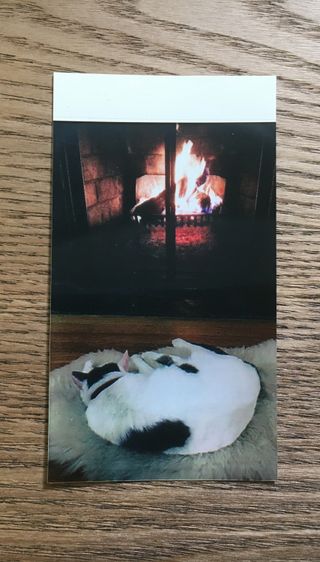Kodak Mini Shot Instant Camera Review: Skip It
This instant camera/Bluetooth printer disappoints at both its tasks.
Why you can trust Tom's Guide

Instant cameras are fun, retro-style toys, and portable photo printers are great for people who want to physically share images they just took with their smartphones. The Kodak Mini Shot is a fantastic idea, as it combines both of those ideas into one device: Not only can you take photos with this $99 camera, but you can also connect to it via Bluetooth from your smartphone and use it to print out photos. It's too bad that this camera doesn't perform either function well.
Design
The rectangular Mini Shot comes in black, white, or yellow and white; the latter is much more fun and is reminiscent of Kodak's trademark colors. On top is a power button next to a larger shutter button; the rear has a 1.7-inch LCD, and a five-button pad on the back lets you select photos, print them and more. Along the left side is a slot for the printed photos, and the right side has a micro USB port for recharging the built-in battery.
The bottom of the camera pops out when it's time to replace the printer cartridge, but there's no way of knowing how many shots you have left. This was really annoying after I took a photo and tried to print it out, only to discover there was no paper left in the camera.

Unlike the Kodak Printomatic, which has a microSD card slot and saves a digital copy of your photos, the Mini Shot has no storage. So there's no way to save your photos, except to print them immediately.
The resolution of its small, 1.7-inch display was so low that it was hard to tell if anything was in focus.
Performance
I don't expect a $99 camera to perform as well as a DSLR, but some things could stand improvement on the Mini Shot. The resolution of its small, 1.7-inch display was so low that it was hard to tell if anything was in focus. Additionally, it takes a long time for the screen to refresh when you move the camera around or if the subject is moving.

You can take one or two photos after a low-battery warning appears on screen, but after that, you have to recharge the camera before you can make another print.
Print Quality
While the Printomatic uses Zink paper, the Mini Shot has an actual mini-printer inside. This resulted in more-saturated prints than the Printomatic produced, but the Kodak camera had trouble in all sorts of lighting conditions.

Both outdoors and indoors, the Mini Shot failed to adequately compensate scenes that had a wide dynamic range (areas with a lot of brightness and dark areas). Brighter areas tended to get washed out.

For example, the foreground of an indoor photo of a train set was completely white, and while the train itself was properly exposed, it was blurry — no doubt a result of the camera slowing its shutter speed. However, enabling the camera's flash merely resulted in a photo that was even more washed out.
With the Mini Shot, you have to wait for the printing process to finish before you can take additional photos.
Printing is anything less than instant. The 2.1 x 3.4-inch paper goes in and out of the camera four times, one time for each color (cyan, magenta, yellow) and a final time for a finish laminate. In all, you have to wait about 30 seconds.
That's roughly the same time as you would have to wait for Zink or Polaroid to fully develop. But with those cameras, at least you can take additional photos during that time. With the Mini Shot, you have to wait for the printing process to finish.
A replacement cartridge with 20 sheets of paper costs $14.99, which is about twice as expensive as similar-size Zink paper, but slightly less expensive than Fujifilm Instax photo paper.
App
The Mini Shot can also double as a Bluetooth printer; using the Mini Shot app (for Android and iOS), you can connect your phone wirelessly to the camera and print out photos taken with your smartphone.

On this app, you can adjust settings such as brightness, contrast and saturation; add text and stickers; apply Instagram-like filters; and use templates, such as Christmas and Birthday, to add a thematic element.

This is a fun feature, but don't expect the highest quality. A photo I took of one of my cats sleeping by a fire looked a bit dingy. An outdoor shot of my wife and our dog came out better, but slightly faded.
Bottom Line
The $99 Kodak Mini Shot Instant Camera boasts a few advantages over the $69 Kodak Printomatic but falls short in other ways. Photos from the Mini Shot were more colorful than the Printomatic's, and I liked that the Mini Shot could also print photos from my smartphone — something the Printomatic can't do. However, the Mini Shot's display was atrocious, and I was disappointed that it didn't store digital images, a feature found on the Printomatic.

If you're looking for an instant camera, go with Fujifilm's Instax Mini 9; it doesn't save digital copies, but it produces better-quality prints. If you're looking for an inexpensive digital camera, go with the Sony WSC-800. Ultimately, the Kodak Mini Shot does a number of things, but doesn't do any of them well.
Credit: Tom's Guide
Sign up to get the BEST of Tom’s Guide direct to your inbox.
Upgrade your life with a daily dose of the biggest tech news, lifestyle hacks and our curated analysis. Be the first to know about cutting-edge gadgets and the hottest deals.

Michael A. Prospero is the U.S. Editor-in-Chief for Tom’s Guide. He oversees all evergreen content and oversees the Homes, Smart Home, and Fitness/Wearables categories for the site. In his spare time, he also tests out the latest drones, electric scooters, and smart home gadgets, such as video doorbells. Before his tenure at Tom's Guide, he was the Reviews Editor for Laptop Magazine, a reporter at Fast Company, the Times of Trenton, and, many eons back, an intern at George magazine. He received his undergraduate degree from Boston College, where he worked on the campus newspaper The Heights, and then attended the Columbia University school of Journalism. When he’s not testing out the latest running watch, electric scooter, or skiing or training for a marathon, he’s probably using the latest sous vide machine, smoker, or pizza oven, to the delight — or chagrin — of his family.
